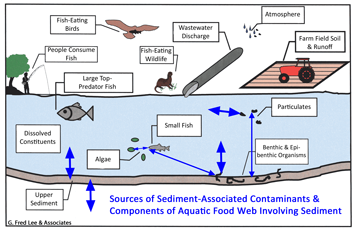- Aquatic sediments tend to accumulate potential pollutants
- e.g., heavy metals, larger organics, nutrients
- Sediment-associated potential pollutants exist in a variety of chemical forms
- only small portion are toxic/available in sediment or when re-suspended in water
- cannot reliably distinguish availability based on chemical concentration analyses
- no relationship between total concentration of potential pollutant in sediment and its impact on water quality or sediment organisms
- �Co-occurrence�-based (e.g., �Long & Morgan�-type) target/trigger concentrations for sediment quality assessment not technically valid and not reliable even for "screening"
- Inclusion of sediment chemical concentrations in "weight-of-evidence" assessment renders results unreliable
- Heavy metals & larger organics present in sediment are often not the cause of observed toxicity
-- Toxicity often caused by ammonia or low-DO associated with algal growth
-- "Remediating" heavy metals & larger organics in sediment would not remediate the toxicity
- Important to identify sediments of concern based on impacts (e.g., toxicity, body burden of edible organisms), NOT on concentration of a chemical or group of chemicals in sediment
- To reliably assess & manage sediments of concern, conduct site-specific evaluations interpreted in non-numeric BPJ weight-of-evidence format
- TIEs to determine toxicity & sources of toxity
- Organism-based bioavailability studies focused on edible organisms
- Not valid or reliable to regulate chemicals in sediments with chemical-concentration-based criteria/standards/guidelines

|





|




![]() Return to G. Fred Lee & Associates Home Page
Return to G. Fred Lee & Associates Home Page